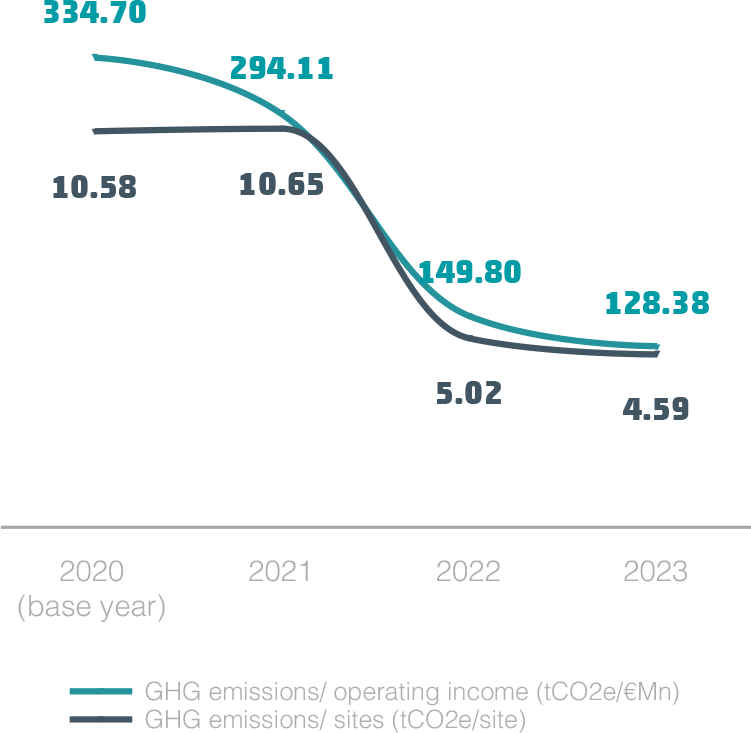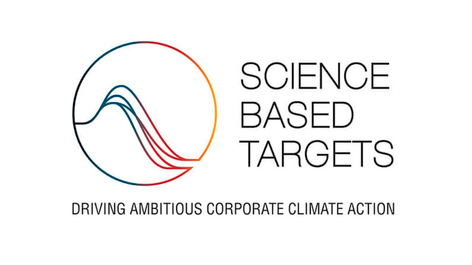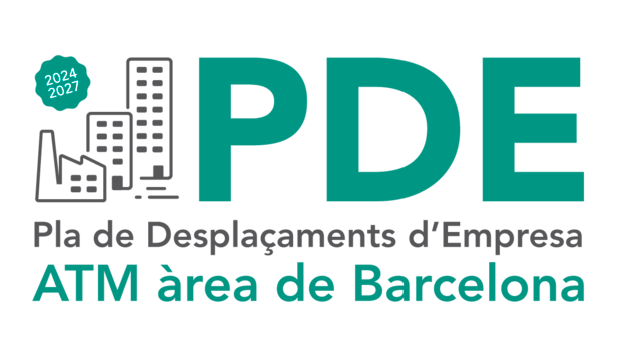The Greenhouse Gas (GHG) emissions inventory is a key instrument for understanding the global impact of the company's activities on climate change, as well as the development of GHG emissions over time and Cellnex's value chain. This year, therefore, Cellnex has calculated and certified Scope 1, 2 and 3 of the Carbon Footprint through an independent external body, following the ISO 14064-1:2018 standard and the criteria of the GHG Protocol. These calculations encompass all countries and corporate levels. Additionally, internal audits related to the carbon footprint have been conducted since 2021, with audits performed in six countries (UK, France, Poland, Corporate, Austria, Switzerland) in 2023.
Since 2021, in addition to the ISO 14064-1:2018 standard, emissions are reported and verified according to the classification established by the Corporate Accounting and Reporting Standard of the Greenhouse Gas Protocol (GHG Protocol), developed by the World Business Council for Sustainable Development. In the case of Scope 3 emissions, the classification established in the GHG Protocol publication "Corporate Value Chain Accounting and Reporting Standard (Scope 3)" is used.
According to the verification, the verified emissions inventory for 2023 is 519,804 tCO2e using the market-based approach (recalculated at 558,011 and 931,409 tCO2e in 2022 and 2021, respectively).

It is important to highlight the reduction in Scope 3 emissions due to two important factors:
GHG emissions by scope in 2023
In line with the GHG protocol with the market-based approach, 92.3% of the emissions correspond to Scope 3, followed by Scope 2 with 7.1% and Scope 1 with 0.6% of GHG emissions.
|
Carbon emissions according to GHG Protocol (t CO2e) (market-based) |
||
|
Category |
2023 |
2020 (Base year) |
|
Scope 1: direct emissions |
3,016 |
3,940 |
|
Scope 2: indirect emissions |
36,798 |
432,160 |
|
Scope 3: other indirect emissions |
479,990 |
629,210 |
|
3.1. Goods and services purchased |
31,200 |
37,138 |
|
3.2. Capital goods |
38,518 |
43,819 |
|
3.3 Fuel and energy-related activities |
51,393 |
88,937 |
|
3.4. Transport and distribution upstream |
NA |
16,140 |
|
3.5. Waste generated in operations |
NA |
4,798 |
|
3.6. Business trips |
1,128 |
56,785 |
|
3.7. Displacement of employees |
2,910 |
1,553 |
|
3.8. Leased assets upstream |
111,119 |
114,808 |
|
3.13. Leased assets downstream |
243,721 |
342,177 |
|
Total |
519,804 |
1,065,310 |
In 2023, Cellnex reduced its total emissions compared to its base year (2020) by 51%

Emission intensities have reduced over recent years mainly due to the efforts made in green electricity consumption (scope 2). With regard to this strategy, it is worth highlighting the difference between scope 2 location-based emissions (346,283.75 tCO2e) and market-based emissions (36,798.04 tCO2e). The latter represent about 10 times less than the former, as a indication of Cellnex's commitment to reduce its carbon impact.
The GHG emissions disclosed for 2021 and 2020 (as base year) were recalculated in 2022, due to changes in the perimeter. Further information can be found in Chapter 7.3. Carbon footprint: Scope and calculation methodology.
Since 2015, as part of its efforts to mitigate GHG emissions, Cellnex has offset emissions to achieve neutrality in scope 1 for all the countries. In 2023, Cellnex offset 3,016.01 tCO2e by acquiring 3,016.01 CER (certified emission reduction) credits in the project Wind energy in India Tamil Nadu, adorned with the prestigious "Gold Standard" certification.
As a part of the carbon footprint reduction efforts, Cellnex Poland is in the process of replacing electricity sub-meters on sites with models that enable remote reading. This will reduce unnecessary car trips to visit sites.
Additionally, internal audits related to the carbon footprint and water footprint have been conducted since 2021. In 2023 internal audits were performed in Poland.
At Cellnex Spain, internal actions by the Environmental Department have been integrated with the units purchasing climate equipment. The aim of this collaboration is to select equipment with refrigerants that have lower GWP (Global Warming Potential) in the procurement process.
Total GHG emissions
519,803.67
tCO2e in 2023
(51) % reduction
vs base year 2020
In 2023, Cellnex Spain recorded the results of the calculation of its carbon footprint for 2022 in the official registers of the Generalitat de Cataluña (Climate Change Office). The company adheres to the carbon footprint in the Voluntary Agreements Programme (PAV) and in the Miterd (Ministry for the Ecological Transition and the Demographic Challenge) through registration in the Ministry's Carbon Footprint, Compensation, and CO2 Absorption Projects Register.
 |
45,092 |
2023 |
|
38,407 |
2022 |
|
 |
84,315 |
2023 |
|
101,033 |
2022 |
|
 |
29,253 |
2023 |
|
32,968 |
2022 |
|
 |
3,113 |
2023 |
|
5,723 |
2022 |
|
 |
9,970 |
2023 |
|
24,566 |
2022 |
|
 |
39,241 |
2023 |
|
42,762 |
2022 |
|
 |
18,416 |
2023 |
|
8,726 |
2022 |
|
 |
33,878 |
2023 |
|
31,228 |
2022 |
|
 |
23,418 |
2023 |
|
25,168 |
2022 |
|
 |
767 |
2023 |
|
2,849 |
2022 |
|
 |
1,081 |
2023 |
|
1,051 |
2022 |
|
 |
231,259 |
2023 |
|
243,532 |
2022 |
Cellnex has been working on the roadmap to achieve these objectives, such as defining the 2023-2025 Climate Change Strategy

In line with the recommendations in the TCFD "Metrics and Objectives" pillar, Cellnex recognises the importance of measuring the total emissions that its activity generates, as this enables the Company to draw a roadmap for setting emission reduction targets. These targets are pivotal for achieving climate neutrality.
In 2019, Cellnex committed to developing a science-based emissions reduction target in line with the Science-Based Targets Initiative (SBTi), which aims to increase companies' commitment to sustainable management and seek more ambitious solutions to climate change. Aligned with the Paris Agreement, it aims to help establish science-based climate change strategies to reduce greenhouse gas emissions, limiting global warming to well below 2°C above pre-industrial levels and to continue efforts to limit warming to 1.5°C.
In 2021, Cellnex established three specific objectives for the reduction of emissions, which were validated by the Science-Based Targets initiative (SBTi) and aligned with the Global Pact "Business Ambition for 1.5ºC". These reduction targets are the first essential step in defining Cellnex's Net-zero Strategy.
In 2022, Cellnex worked on the roadmap to achieve these objectives, such as defining the 2023-2025 Climate Change Strategy. Specific actions were also undertaken with suppliers, in addition to energy management actions.
During 2023, the company persisted in advancing towards the fulfilment of its commitments, achieving notable milestones. Noteworthy achievements include the sourcing of 77% of its electricity from renewable sources, a 83% reduction in scope 1 and 2 GHG emissions, and scope 3 GHG emissions related to energy and fuel activities. Additionally, there was a 14% reduction in absolute scope 3 GHG emissions from purchased goods and services, as well as capital goods.
|
Cellnex's achievements in 20233 |
|
77 % sourcing of renewable electricity |
|
(83) % reduction in scope 1 and 2 GHG emissions and scope 3 GHG emissions from fuel and energy-related activities |
|
(14) % reduction in absolute scope 3 GHG emissions from purchased goods and services and capital goods |
|
Cellnex's Science-Based Targets commitments (SBTs) |
||
|
Increasing the annual supply of renewable electricity dfrom 0% in 2020 to
100% in 2025 |
Reducing absolute Scope 1, 2 GHG emissions and Scope 3 GHG emissions (fuels and energy) 70% by 2030,compared to base year 2020 |
Reducing absolute Scope 3 emissions (goods and services and capital goods) by 21% in 2025, compared to base year 2020 |
The most important challenge in the world today is the climate crisis, as the effects of Greenhouse Gases (GHG) emissions have been detected throughout the climate system, generating risks for ecosystems and human beings. In line with the Paris Agreement, which agreed to limit global warming well below 2ºC and to make efforts to limit it to 1.5ºC below pre-industrial levels, priority is given to the development of actions aimed at reducing GHG emissions to substantially minimize climate change-related losses and damages to human systems and ecosystems.
Cellnex's Net-zero Strategy is a key component of the 2023-2025 Environment and Climate Change Strategy, as well as the Company's ESG Master Plan
Within current climate science, one of the measures to address climate change and set global carbon emission limits is the development of "Net-zero", a concept that seeks to achieve a balance between GHG emissions and actions to reduce or eliminate those emissions so that the net amount of GHG in the atmosphere is equal to or very close to zero.
To make Net-zero a useful framework, the global carbon cap must be translated into individual decarbonization pathways for nations, states, subnational entities, corporations, and other organisations. At the corporate level, Net-zero is about developing ambitious emissions reduction measures within the value chain itself, making systemic changes across sectors and addressing active emissions removal, considering the development of actions beyond the organisation's value chain, and implementing emissions offsetting and neutralisation measures.
In line with these climate requirements, Cellnex is actively working to limit the effects of climate change and contribute to the decarbonization of the economy, defining a strategy to reduce, offset and neutralise its emissions with specific medium- and long-term objectives that make up the Cellnex Net-zero Strategy.
1. Science-based reduction targets
2. Energy transition
3. Value chain
4. Circular economy
5. Sustainable
6. Neutralisation of residual emissions
7. Transparency and governance
The Net-zero strategy is a key component of the Environment and Climate Change Strategy 2023-2025, as well as the company's ESG Master Plan, and will enable Cellnex to be a net-zero company by 2050, with the intermediate goal of being Carbon Neutral by 2035.
The Company is developing a roadmap with specific medium and long-term goals to accelerate the transition towards a net-zero business model. The first lines of action that were established set out three types of measures:
To this end, Cellnex has established a strategy to reduce GHG emissions as far as possible and neutralise residual emissions that cannot be reduced. The strategy is structured around the following seven pillars:
Even with the implementation of reduction measures, there are a number of residual emissions that need to be managed by carrying out actions beyond the value chain. For this, Cellnex proposes to allocate climate finance for the purchase of carbon credits generated in carbon reduction/avoidance and sequestration/removal projects within the Voluntary Carbon Market (VCM). The financing of these projects will be governed mainly by compliance with international standards (VCS and Gold Standard) to ensure that these projects meet quality requirements, and that they generate benefits in the communities and ecosystems in which they are developed.
To make Cellnex a net-zero company, it is important to mainstream sustainability and climate change into the day-to-day management of the company for it to operate responsibly in each of its activities and business areas.
For 2023, following the announcement of the commitment to achieve climate neutrality by 2050, Cellnex published a video and a document in which the roadmap of the Net-zero strategy is developed.
"Environmental projects implemented in Poland, such as the project to replace old and worn out models of air conditioning units with new ones, are aimed, among other things, at reducing greenhouse gas emissions into the environment. Such activities are part of the Net-zero strategy adopted by Cellnex"
Adam Stajniak
Field Network Maintenance Department - Cellnex Poland
Cellnex's commitment to the environment extends throughout the value chain through the dedication and commitment of the actors in the Environment and Climate Change Policy chain. In addition, acceptance of Cellnex's commitment is demonstrated through business activities and incorporated into the environmental requirements for suppliers. This commitment is also monitored in outsourced processes, and environmental requirements are outlined in construction and infrastructure projects, among others.
In 2020-2021, a preliminary internal carbon tax was established with the dual purpose of promoting efforts to reduce the company's emissions and fostering a shift in behaviour towards a less emission-intensive activity.
During 2022, a pilot project was conducted in the Procurement Departments, allowing the following main conclusions to be drawn regarding the feasibility of the project and the next steps to be taken:
In this regard, implementation from 2025 onwards is proposed because prior work is required to understand suppliers' emissions. Cellnex’s Supplier Support project in the CDP Supply Chain Programme (currently underway) aims to make progress in this direction.
In 2023 Cellnex has joined the Global Confirming® program, together with Santander bank, which aims to incentivise suppliers in emission reductions through better CDP Climate change scoring. This solution allows advanced payment at an exceptional cost, without consuming bank risk and provides visibility on the payment of invoices at maturity. There is a link between the scores of the CDP and the conditions of the Global Confirming® program. Those suppliers who already have the sustainability criteria of the CDP, will also benefit from a better rate.
Internal tax pilots will be also be explored in the coming years in other areas of emissions such as business travel.
In 2022, Cellnex implemented the environmental and emission reduction requirements under the company's new Supplier Risk Management Model for procurement.
Throughout 2023, Cellnex Spain worked collaboratively with the corporate level to update and refine new environmental requirements for suppliers.
The Health and Safety department at Cellnex, in collaboration with the Environment and Climate Change department, has developed a "Mobility Plan" project to reduce the number of traffic accidents and to ensure that travel by and for Cellnex is as sustainable as possible.
In 2023, a comprehensive global mobility survey was conducted, laying the groundwork for the development of mobility plans tailored to the specific needs of Cellnex offices in Spain (Barcelona and Madrid) and Italy (Rome).
The year saw the implementation of various initiatives, including the introduction of a convenient shuttle service facilitating round-trip commuting between the Rome office and metro B Magliana. Furthermore, a strategic agreement was forged to provide employees with access to 'e-car sharing' services at preferential rates. This initiative enables staff to use full-electric cars, offering a sustainable transport solution for commuting to the headquarters or the airport.
In 2023, the Mobility Plan for the workplace centres located in Madrid and Barcelona was completed and published, identifying improvement actions. Cellnex has recently been awarded the prestigious PDE Commuting Travel Plan seal. This achievement underscores Cellnex's public commitment to adopting practices that promote sustainable mobility in the workplace, aligning with the principles of the Spanish mobility law.
The attainment of the PDE seal is a direct result of a favourable evaluation conducted by the Metropolitan Transport Authority (ATM) regarding Cellnex Travel Plan for Torre Llevant headquarters.Collaborative efforts have been made with the Occupational Risk Prevention (PRL) and Environmental Management (MA) departments of the Corporation and Spain. Furthermore, in 2023, Cellnex staff in Barcelona were trained in sustainable driving.

Before starting...
We use our own and third-party cookies for analytical purposes and to show you personalized advertising based on a profile prepared from your browsing habits (for example, pages visited). Click HERE for more information. You can accept all cookies by pressing the "Accept" button or configure or reject their use by pressing the "Configure" button.
ACCEPT AND CONTINUE Configure cookies